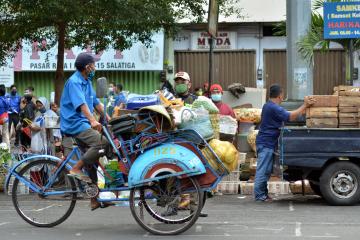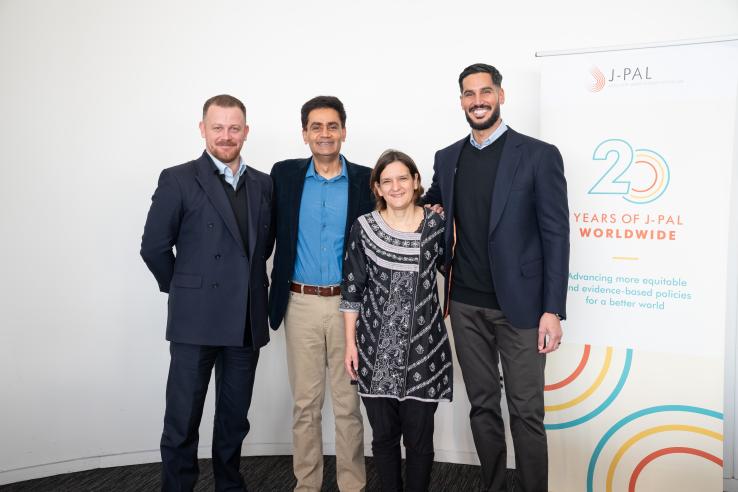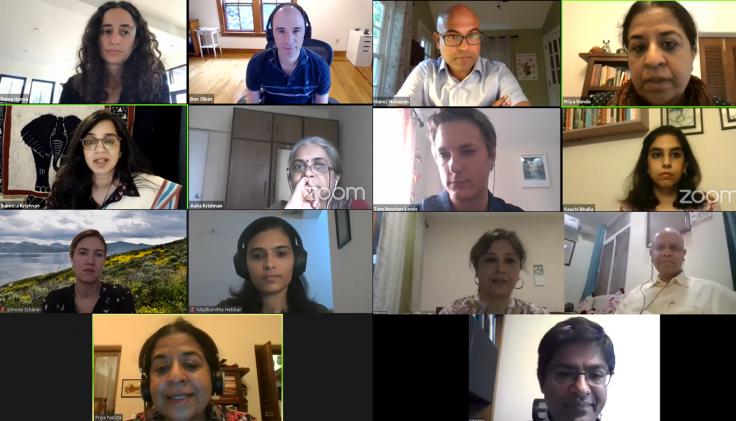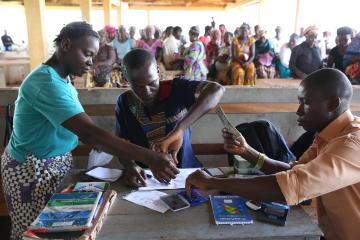
Strengthening social assistance and health response to COVID-19 in India

The COVID-19 pandemic has expanded the proportion of the population in low- and middle-income countries that require social assistance from governments to deal with economic and health vulnerabilities. This crisis highlights the need to think carefully about the design features of these social assistance schemes so that they reach those who need support the most.
When the pandemic first hit, many countries provided top-ups on existing benefits and relied on the current infrastructure to deliver social assistance. However, as the economic downturn continues, social assistance systems must be expanded to make them more inclusive and accessible.
But how might this be done? From July–October 2020, J-PAL South Asia’s Cash Transfers for Child Health Initiative (CaTCH) organized a webinar series through which J-PAL affiliates, donors, researchers, and implementing organizations came together to share evidence on how social protection programs can be leveraged, designed, and implemented to mitigate the impacts of the COVID-19. The panelists also discussed how the ongoing crisis has impacted health system response and utilization.
How can social protection programs better target vulnerable populations?
In the first webinar, Ben Olken (MIT; Director, J-PAL; Co-Scientific Director, J-PAL SEA) and Rema Hanna (Harvard; Co-Scientific Director, J-PAL SEA) highlighted the unique challenges presented by the COVID-19 crisis for social protection: many social assistance programs have weak targeting and delivery channels, and are now further curtailed by limited fiscal space. The researchers argued that there is a need to tailor the economic response to COVID-19 to the public health response. For instance, during intense lockdown periods where economic activity is severely curtailed, more universal and broad transfers are needed. Direct food assistance can be particularly useful in this scenario, since they allow for self-targeting.

Once lockdowns are lifted, targeting becomes much more important. Drawing from previous work in Indonesia and Peru, Olken and Hanna argued that targeted programs—those focused on distributing large benefits per-capita to poor households—appear to achieve much higher social welfare than broadly targeted programs, including but not limited to a universal basic income. However, governments need to be careful about mistakenly excluding eligible beneficiaries when implementing targeted programs.
Proxy means testing is often a popular choice for governments when determining target groups for social protection programs. In the absence of reliable data on income, policymakers often rely on observable assets in this method of beneficiary identification. However, during COVID-19, this approach may lead to the exclusion of those who have become newly vulnerable.
One possible alternative to consider is community-based targeting, which Olken and Hanna have found to be effective in other contexts. In a randomized evaluation conducted in Indonesia, researchers found that community-based targeting, where local community institutions identify beneficiaries, led to the creation of beneficiary lists with more individuals who self-identify as poor and better community satisfaction.
Self-targeting, where beneficiaries are asked to apply, has also worked better compared to proxy-means tests, but particularly for the Indian context, it is important to not make the application process too cumbersome and complicated, as this might impose additional application costs that affect more vulnerable groups disproportionately.
A key issue to consider when designing social assistance programs is how they might be made more sensitive to particularly vulnerable groups of beneficiaries. When social assistance programs are designed to include vulnerable groups, there can be unexpected positive benefits. For example, Simone Schaner (University of Southern California) discussed how a study on increasing women’s financial inclusion and control in Madhya Pradesh revealed that direct deposits to women’s bank accounts, combined with training on how to use the bank accounts, improved female labor force participation and made gender norms with respect to women’s work more progressive.
Technology and digitization for program delivery
Leveraging technology and digitization for social protection programs can also be a powerful solution. However, a rapid switch to digital systems that are not well designed or flexible might leave us with an inefficient system that is hard to change later. Olken and Hanna shared that in Indonesia, when internet registration was offered for a health insurance scheme, many people attempted—but failed—to enroll due to technical and administrative challenges in the web-based enrollment system, particularly an inaccurate database of eligible beneficiaries.
Karthik Muralidharan (UC San Diego; Co-Chair, J-PAL’s Education sector) also discussed this challenge. A study in Jharkhand found that the rollout of Aadhar-based biometric authentication in the Public Distribution System (PDS) did not reduce leakages and diminished benefits for those who needed it. This stood in contrast to an evaluation in Andhra Pradesh where biometric smart cards led to faster and less corrupt payment processes in India’s national workfare program, Mahatma Gandhi National Rural Employment Guarantee Act.
This research suggests that the use of biometric ID technology for program delivery works when focused on beneficiary experience and should be flexible with respect to previously unenrolled beneficiaries. Madhumitha Hebbar of Oxford Policy Management also discussed how digitization in social assistance programs often serves the purpose of centralized oversight and does not focus sufficiently on empowering frontline implementation staff and beneficiaries.
Karthik Muralidharan argued that while direct benefit transfers are a powerful tool for faster delivery of social assistance, recent evidence suggests that when imperfectly implemented, they can have costly consequences in terms of wrongful exclusion. In his webinar on “An Inclusive Growth Dividend,” he discussed research on the substitution of PDS benefits with direct benefit transfers, which showed that despite government records reporting a 99 percent success rate in the delivery of transfers, a third of households reported not receiving them. In an ongoing study in Jharkhand on India’s flagship maternity benefit scheme, the researchers found that 30–50 percent of women report being excluded from benefits.
The impact of COVID-19 on routine health service delivery
In addition to sharing insights and findings related to social protection programs, the webinar series also featured panel discussions on challenges faced by the Indian healthcare system and how COVID-19 has impacted the delivery of routine health services. Pascaline Dupas (Stanford; Co-Chair, J-PAL’s Health sector) and Radhika Jain presented results from research conducted through phone surveys in Rajasthan on how COVID-19 has been associated with substantial disruptions to dialysis care due to travel barriers, hospital closure and service refusal, fear of COVID-19, and limited medicine access. They found that post-lockdown morbidity, hospitalization, and mortality was strongly positively correlated with such care disruptions during the lockdown. This effect was larger for women. Care disruptions decreased, but persisted, into July and August 2020.
Dupas and Jain also presented their preliminary analysis of immunization delivery during the lockdown. They found that households report disruptions to immunization due to fear of COVID-19, and as a result, the full immunization rate remains low for children who turned one-year-old between March and May 2020. However, they found that there was substantial catch-up on immunization take-up in the later months.
Beyond the pandemic, Tom Newton Lewis of Oxford Policy Management discussed findings from research on community health worker (CHW) performance in Bihar. State governments in India rely on a worker cadre of accredited social health activists (ASHAs) and auxiliary nurse midwives (ANMs) for last-mile program delivery. ASHAs and ANMs have been at the frontline during COVID-19 as well, for contract tracing, surveillance, and other health services.
Newton-Lewis argued that traditional models of constraints to frontline worker performance miss ground realities and that CHWs underperform not due to lack of incentives, but due to insufficient technical knowledge and lack of resources to deliver on their goals. CHWs are required to persuade people to do things, and this requires them to have high levels of trust and strong relationships with their communities. Empowering CHWs and raising their stature in the community may be the key to unlocking their performance potential. He argues that supportive supervision and making in-service training more skill-centric could help achieve this.
Social assistance programs have the potential to mitigate the impact of COVID-19 on vulnerable groups. This crisis is also an opportunity to identify the limitations of these programs as they are currently designed and implemented. Strategies to improve delivery of these programs, such as utilizing technology or substituting assistance programs for cash, need to consider beneficiary experience, constraints to frontline worker performance, and the substantial cost of wrongful exclusion.




